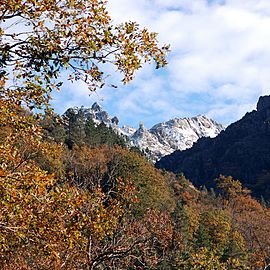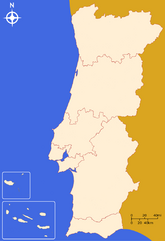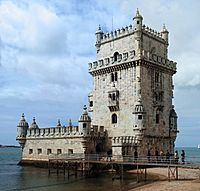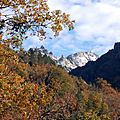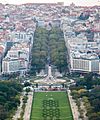Portugal facts for kids
Quick facts for kids
Portuguese Republic
República Portuguesa
|
|
|---|---|
![Location of Portugal (dark green)– on the European continent (green & dark grey)– in the European Union (green) — [Legend]](/images/thumb/a/a0/EU-Portugal_with_islands_circled.svg/350px-EU-Portugal_with_islands_circled.svg.png)
Location of Portugal (dark green)
– on the European continent (green & dark grey) |
|
| Capital and largest city
|
Lisbon |
| Official languages | Portuguese |
| Recognised regional languages | Mirandese1 |
| Ethnic groups
(2007)
|
96.87% Portuguese and 3.13% other ethnicities (Cape Verdeans, Brazilians, Ukrainians, Goans, Angolans, etc.) |
| Demonym(s) | Portuguese |
| Government | Unitary parliamentary republic |
| Marcelo Rebelo de Sousa (PSD) | |
| António Costa (PS) | |
|
• Assembly President
|
Ferro Rodrigues (PS) |
| Formation
Conventional date for Independence is 1139
|
|
|
• Founding
|
868 |
|
• Re-founding
|
1095 |
| 24 June 1128 | |
|
• Kingdom
|
25 July 1139 |
| 5 October 1143 | |
|
• Papal Recognition
|
23 May 1179 |
| 1 December 1640 | |
| 13 February 1668 | |
|
• Republic
|
5 October 1910 |
|
• Democracy
|
25 April 1974 |
| Area | |
|
• Total
|
92,090 km2 (35,560 sq mi) (110th) |
|
• Water (%)
|
0.5 |
| Population | |
|
• 2011 estimate
|
10,647,763 (77th) |
|
• 2011 census
|
10,555,853 |
|
• Density
|
115/km2 (297.8/sq mi) (96th) |
| GDP (PPP) | 2010 estimate |
|
• Total
|
$247.037 billion (48th) |
|
• Per capita
|
$23,222 (39th) |
| GDP (nominal) | 2010 estimate |
|
• Total
|
$229.336 billion (37th) |
|
• Per capita
|
$21,558 (32nd) |
| Gini (2009) | 33.7 medium |
| HDI (2011) | very high · 41st |
| Currency | Euro (€)2 (EUR) |
| Time zone | UTC+0 (WET) |
|
• Summer (DST)
|
UTC+1 (WEST) |
| Date format | dd-mm-yyyy, yyyy-mm-dd, yyyy/mm/dd |
| Driving side | right |
| Calling code | 351 |
| ISO 3166 code | PT |
| Internet TLD | .pt |
|
|
Portugal is a country in Southern Europe on the Iberian Peninsula. Portugal is the westernmost country of Europe. It is bordered by the Atlantic Ocean to the west and south and by Spain to the north and east.
Three groups of islands in the Atlantic Ocean are also part of Portugal: the Azores (Açores), Madeira and the Savage Isles (Ilhas Selvagens). The Savage Isles are a small group of uninhabited islands, administered by Madeira. Portugal claims that Olivença is also part of its territory, but it is controlled by Spain.
Contents
History
Portugal became its own kingdom in 1139 but was not officially recognized until 1143. The border with Spain has been almost the same since the 13th century. Fishing and trade with other countries are important here.
Portugal was important in world exploration for two reasons. Henry the Navigator, a prince from Portugal, was very interested in exploration. Inventions in navigation led to a bigger knowledge of geography.
This world exploration began the Portuguese Empire. Portugal was a world power during the 15th and 16th centuries. However, it lost a lot of money soon after this. The city of Lisbon was destroyed in an earthquake in 1755. The country was occupied during the Napoleonic Wars. It lost its largest colony, Brazil, in 1822.
In 1910, Portugal became a Republic, and in 1926, a military group took control of the country from the Portuguese 1st Republic. This began a time of rule by fascist governments that lasted until 1974. That year, a peaceful left-wing army coup, called the Carnation Revolution, happened. The coup changed how the country was run.
The next year, Portugal allowed its colonies in Africa to be on their own: Mozambique, Angola, Guinea-Bissau, Cape Verde and São Tomé and Príncipe.
East Timor in Asia declared itself independent from Portugal on 28 November 1975, and was invaded and occupied by Indonesian forces nine days later.
Portugal went into the European Union in 1986. Another Asian colony, Macau, became part of China
The main language of Portugal is Portuguese.
Some famous Portuguese people are D. Afonso Henriques, Henry the Navigator, Bartolomeu Dias, Vasco da Gama, Pedro Álvares Cabral, Ferdinand Magellan, Luís de Camões, Fernando Pessoa, Amália Rodrigues, Álvaro Siza Vieira, Eduardo Souto de Moura.
Luís de Camões wrote the national poem of Portugal. It is called Os Lusíadas and was written in 1572.
Geography
The territory of Portugal includes an area in the Iberian Peninsula (referred to as the continent by most Portuguese) and two archipelagos in the Atlantic Ocean: the archipelagos of Madeira and the Azores. It lies between latitudes 33° and 43° N, and longitudes 32° and 6° W.
Mainland Portugal is split by its main river, the Tagus, that flows from Spain and disgorges in Tagus Estuary, in Lisbon, before escaping into the Atlantic. The northern landscape is mountainous towards the interior with several plateaus indented by river valleys, whereas the south, including the Algarve and the Alentejo regions, is characterized by rolling plains.
Portugal's highest peak is the similarly named Mount Pico on the island of Pico in the Azores. This ancient volcano, which measures 2,351 m (7,713 ft) is an iconic symbol of the Azores, while the Serra da Estrela on the mainland (the summit being 1,991 m (6,532 ft) above sea level) is an important seasonal attraction for skiers and winter sports enthusiasts.
The archipelagos of Madeira and the Azores are scattered within the Atlantic Ocean: the Azores straddling the Mid-Atlantic Ridge on a tectonic triple junction, and Madeira along a range formed by in-plate hotspot geology. Geologically, these islands were formed by volcanic and seismic events. The last terrestrial volcanic eruption occurred in 1957–58 (Capelinhos) and minor earthquakes occur sporadically, usually of low intensity.
Portugal's exclusive economic zone, a sea zone over which the Portuguese have special rights over the exploration and use of marine resources, has 1,727,408 km2. This is the 3rd largest exclusive economic zone of the European Union and the 11th largest in the world.
Climate
Portugal is defined as a Mediterranean climate (Csa in the South, interior, and Douro region; Csb in the North, Central Portugal and coastal Alentejo; mixed oceanic climate along the northern half of the coastline, Temperate Maritime (Cfb) in the mountains located in Northwestern sector (mainland) and also in some Azores islands, Semi-arid climate or Steppe climate ((BSk in certain parts of Côa region and Beja district far South), and also in Porto Santo island (BSh), Warm Desertic (BWh) in Selvagens islands, Subtropical Humid in Corvo island (Cfa), according to the Köppen-Geiger Climate Classification), and is one of the warmest European countries: the annual average temperature in mainland Portugal varies from 8–12 °C (46.4–53.6 °F) in the mountainous interior north to 16–20 °C (60.8–68.0 °F) in the south and on the Guadiana river basin. There are however, variations from the highlands to the lowlands: Spanish biologist Salvador Rivas Martinez presents several different bioclimatic zones for Portugal. The Algarve, separated from the Alentejo region by mountains reaching up to 900 metres (3,000 ft) in Alto de Fóia, has a climate similar to that of the southern coastal areas of Spain or Southwest Australia.
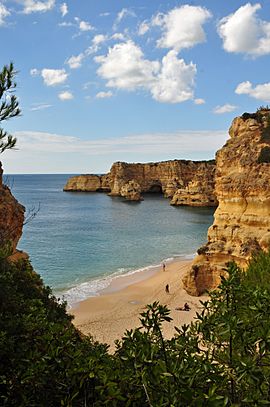
Portugal has around 2500 to 3200 hours of sunshine a year, an average of 4–6 h in winter and 10–12 h in the summer, with higher values in the south-east and lower in the north-west.
Biodiversity
Despite the fact that humans have occupied the territory of Portugal for thousands of years, something still remains of the original vegetation. In Gerês both mature deciduous and coniferous forests can be found, an extremely rare worldwide mature Mediterranean forest remain in some parts of the Arrábida mountain and a subtropical laurissilva forest, dating back to the Tertiary period, covers its largest continuous area in the world in the Madeira main island. Due to the human population decrease and rural exodus, Pyrenean oak and other local native trees are colonizing many abandoned areas.
Boar, Iberian red deer, roe deer, and the Iberian wild goat, are reported to have expanded greatly during recent decades. Boars were found recently roaming at night inside large urban areas, like in Setubal. Protected areas of Portugal include one national park, 12 natural parks, nine natural reserves, five natural monuments, and seven protected landscapes, which include the Parque Nacional da Peneda-Gerês, the Parque Natural da Serra da Estrela and the Paul d'Arzila.
These natural environments are shaped by diverse flora, and include widespread species of pine (especially the Pinus pinaster and Pinus pinea species), the English oak (Quercus robur), the Pyrenean oak (Quercus pyrenaica) the chestnut (Castanea sativa), the cork-oak (Quercus suber), the holm oak (Quercus ilex) or the Portuguese oak (Quercus faginea). Due to their economic value, some species of the genus Eucalyptus were introduced and are now common, despite their environmental impact.
Laurisilva is a unique type of subtropical rainforest, which nowadays, in Europe, is only restricted to the Iberian Peninsula: in the Azores, and in particular on the island of Madeira, there are large forests of endemic Laurisilva (the latter protected as a natural heritage preserve). There are several species of diverse mammalian fauna, including the fox, badger, iberian lynx, iberian wolf, wild goat (Capra pyrenaica), wild cat (Felis silvestris), hare, weasel, polecat, chameleon, mongoose, civet, the occasional brown bear and many others. Portugal is an important stopover for migratory birds, in places such as Cape St. Vincent or the Monchique mountains, where thousands of birds cross from Europe to Africa during the autumn or in the spring (return migration).
Most of the avian species congregate along the Iberian Peninsula since it is the closest stopover between Northern Europe and Africa. Six hundred bird species occur in Portugal (either for nesting or during the course of migration), and annually there are new registries of nesting species. The archipelagos of the Azores and Madeira are transient stopover for American, European, and African birds, while continental Portugal mostly encounters European and African bird species.
There are more than 100 freshwater fish species, varying from the giant European catfish (in the Tagus International Natural Park) to some small and endemic species that live only in small lakes (along the western portion of country, for example). Some of these rare and specific species are highly endangered because of habitat loss, pollution and drought. Up-welling along the west coast of Portugal makes the sea extremely rich in nutrients and diverse species of marine fish; the Portuguese marine waters are one of the richest in the world. Marine fish species are more common, and include thousands of species, such as the sardine (Sardina pilchardus), tuna and Atlantic mackerel. Bioluminescent species are also well represented (including species in different colour spectrum and forms), like the glowing plankton that are possible to observe on some beaches.
There are many endemic insect species, most only found in certain parts of Portugal, while other species are more widespread like the stag beetle (Lucanus cervus) and the cicada. The Macaronesian islands (Azores and Madeira) have many endemic species (like birds, reptiles, bats, insects, snails and slugs) that evolved independently from other regions of Portugal. In Madeira, for example, it is possible to observe more than 250 species of land gastropods.
Administrative divisions
Administratively, Portugal is divided into 308 municipalities (municípios or concelhos), which after a reform in 2013 are subdivided into 3,092 civil parishes (Portuguese: freguesia). Operationally, the municipality and civil parish, along with the national government, are the only legally local administrative units identified by the government of Portugal (for example, cities, towns or villages have no standing in law, although may be used as catchment for the defining services). Continental Portugal is agglomerated into 18 districts, while the archipelagos of the Azores and Madeira are governed as autonomous regions; the largest units, established since 1976, are either mainland Portugal and the autonomous regions of Portugal (Azores and Madeira).
The 18 districts of mainland Portugal are: Aveiro, Beja, Braga, Bragança, Castelo Branco, Coimbra, Évora, Faro, Guarda, Leiria, Lisbon, Portalegre, Porto, Santarém, Setúbal, Viana do Castelo, Vila Real and Viseu – each district takes the name of the district capital. Within the European Union NUTS system, Portugal is divided into nine regions: the Azores, Alentejo, Algarve, Centro, Lisboa, Madeira, Norte, Oeste e Vale do Tejo and Península de Setúbal, and with the exception of the Azores and Madeira, NUTS areas are subdivided into 28 subregions. Population estimates from 2023.
| Region | Capital | Area | Population | ||
|---|---|---|---|---|---|
| 1 | North Region | Porto | 21,278 km2 (8,215 sq mi) | 3,673,861 | |
| 2 | Central Region | Coimbra | 22,636 km2 (8,740 sq mi) | 1,695,635 | |
| 3 | West and Tagus Valley | Santarém | 9,839 km2 (3,799 sq mi) | 852,583 | |
| 4 | Greater Lisbon | Lisbon | 1,580 km2 (610 sq mi) | 2,126,578 | |
| 5 | Setúbal Peninsula | Setúbal | 1,421 km2 (549 sq mi) | 834,599 | |
| 6 | Alentejo Region | Évora | 27,329 km2 (10,552 sq mi) | 474,701 | |
| 7 | Algarve Region | Faro | 4,997 km2 (1,929 sq mi) | 484,122 | |
| 8 | Madeira Autonomous Region | Funchal | 801 km2 (309 sq mi) | 256,622 | |
| 9 | Azores Autonomous Region | Ponta Delgada | 2,351 km2 (908 sq mi) | 241,025 |
Culture
Portugal has developed a specific culture while being influenced by various civilizations that have crossed the Mediterranean and the European continent, or were introduced when it played an active role during the Age of Discovery. In the 1990s and 2000s (decade), Portugal modernized its public cultural facilities, in addition to the Calouste Gulbenkian Foundation established in 1956 in Lisbon.
These include the Belém Cultural Centre in Lisbon, Serralves Foundation and the Casa da Música, both in Porto, as well as new public cultural facilities like municipal libraries and concert halls that were built or renovated in many municipalities across the country. Portugal is home to 17 UNESCO World Heritage Sites, ranking it 9th in Europe and 18th in the world.
Related pages
Images for kids
-
Roman Temple of Évora, in the Alentejo, is one of the best preserved Roman-built structures in the country.
-
Suebi King Miro and St. Martin of Braga; c. 1145
-
Statue of Ibn Qasi outside the Castle of Mértola, in the Alentejo
-
A statue of Count Vímara Peres, first Count of Portugal
-
Alfonso VI of León investing Henry, Count of Portugal, in 1093
-
Afonso Henriques was the last Count of Portugal and the first King of Portugal after winning the Battle of Ourique in 1139.
-
Areas across the world that were, at one point in their history, part of the Portuguese Empire
-
The 1st Marquis of Pombal effectively ruled Portugal as an enlightened despot during the reign of King Joseph I.
-
Left to right: President Bernardino Machado, President Teófilo Braga, President António José de Almeida, and Prime Minister Afonso Costa; 1911
-
António de Oliveira Salazar ruled Portugal from 1932 to 1968, within the Estado Novo regime.
-
Mário Soares became Portugal's first democratically elected Prime-Minister in 1976.
-
The Treaty of Lisbon was signed in 2007, when Portugal held the presidency for the European Council.
-
Chameleo from Algarve
-
November 2011 protests against austerity measures outside the Assembly of the Republic
-
A Portucel Soporcel pulp and paper factory in Setúbal
-
Vasco da Gama Bridge is the longest bridge in the EU.
-
King Diniz statue at the University of Coimbra: the first university in Portugal (now the University of Coimbra), then called the Estudo Geral (General Study), was founded in Lisbon with his signing of the document Scientiae thesaurus mirabilis in Leiria on 3 March 1290.
-
Amália Rodrigues, known as the Queen of Fado, performing in 1969
-
Domingos Sequeira was one of the most prolific neoclassical painters. (Adoration of the Magi; 1828)
-
Cristiano Ronaldo is consistently ranked as one of the best football players in the world and considered to be one of the greatest players of all time.
See also
 In Spanish: Portugal para niños
In Spanish: Portugal para niños





